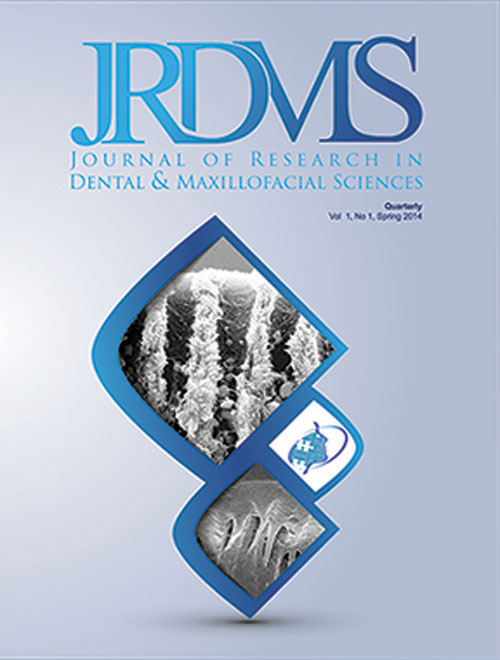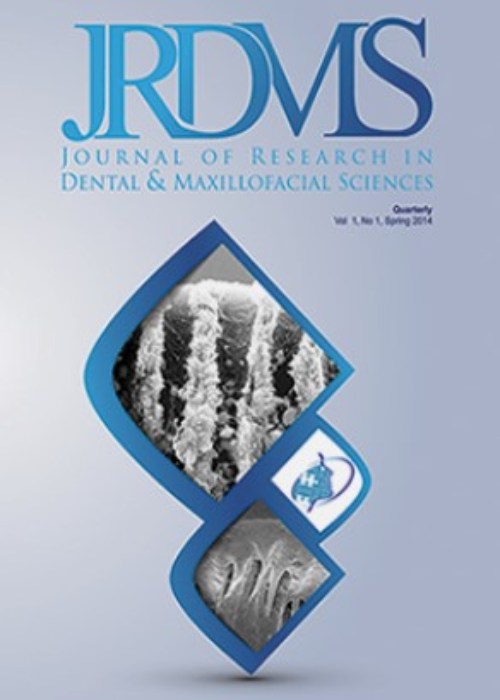فهرست مطالب

Journal of Research in Dental and Maxillofacial Sciences
Volume:5 Issue: 1, Winter 2020
- تاریخ انتشار: 1398/12/05
- تعداد عناوین: 7
-
Pages 1-7Background and Aim
Most dentists rely on the patient's history when assessing a patient's medical status although many patients are unaware of their medical condition. We aimed to evaluate patients' knowledge of their blood pressure (BP) and blood glucose (BG) at the Dental Faculty of Islamic Azad University of Medical Sciences, Tehran, Iran, in 2018.
Materials and MethodsIn this cross-sectional study, 200 patients aged 18 years and over were enrolled with consent. Patients' body mass index (BMI) was classified according to the World Health Organization (WHO) criteria. Patients' BP was measured from the right arm and was considered abnormal when BP≥140/90 mmHg based on the JNC7 criteria. BG levels were measured from the capillary blood of the third finger of patients’ hands and were classified according to the American Diabetes Association (ADA) criteria. Data were analyzed using the chi-square test.
ResultsEighty-nine male patients (44%) and 111 female patients (56%) with the mean age of 44±14.1 years were studied. Thirty percent of the subjects had high BP, and 21% had diabetes. Thirteen percent and 9.5% of the subjects were not aware of their high BP and BG, respectively. Lack of awareness of hypertension was significantly associated with being male and with a BMI higher than normal. Lack of awareness of high BG was associated with being male, older age, a BMI higher than normal, and lower education level (P<0.05).
ConclusionIt seems that knowledge of BP and BG in dental patients is inadequate and requires more precision and sensitivity in assessing these cases before any dental intervention.
Keywords: Body Mass Index, Hypertension, Diabetes Mellitus, Blood Pressure, Blood Glucose, Awareness -
Pages 8-12Background and Aim
Traumatic dental injuries (TDIs) are among the urgent challenges in dental sciences. These types of trauma are a common dental health problem, which may affect hard tissues and tooth-supporting structures. Since dentists’ knowledge and practice are vital for TDI treatments, this study aimed to assess the levels of knowledge of TDIs among general dentists working in Bandar Abbas, Iran.
Materials and MethodsThis cross-sectional study was conducted on 97 general dentists working in the city of Bandar Abbas, Iran, using a three-part questionnaire comprising items about demographic characteristics, knowledge of TDI causes, and knowledge of TDI treatments. Descriptive and analytical statistical analyses of data were performed according to Mann-Whitney and Kruskal-Wallis tests using SPSS 20 software at the significance level of 0.05.
ResultsNinety-seven general dentists, including 61 men and 36 women, participated in this study. The findings revealed that 60.9% and 46.4% of these dentists had high levels of knowledge about TDI causes and treatments, respectively. The mean score obtained by the general dentists was 11.86±2.87, which was promising. A significant relationship was observed between university affiliation and levels of knowledge (P=0.002).
ConclusionAccording to the results, knowledge about common causes and treatments of TDI was at a favorable level among the general dentists working in Bandar Abbas. There was a significant relationship between university affiliation and levels of knowledge; dentists who graduated from universities located in the city of Tehran, Iran, had higher levels of knowledge than others did.
Keywords: Knowledge, Trauma, Children, Dentoalveolar -
Pages 13-20Background and Aim
Bone density is of great assistance in the selection of the proper implant site. The present study aimed to assess the correlation between tissue densities in computed tomography (CT) and three different cone-beam computed tomography (CBCT) units.
Materials and MethodsIn this descriptive study, a radiographic phantom consisting of a transparent polymethyl methacrylate (PMMA) cylinder with a 50-mm height and a 50-mm diameter was used, which comprised eight materials, including air, fat, water, PMMA, muscle, cortical bone, cancellous bone, and aluminum. Each material was of 5 mm height and 5 mm in diameter. A 20-mm-thick hollow plexiglass cylinder was used to simulate the soft tissue. The phantom was scanned four times using 16-Slice Lightspeed CT, NewTom VGi, CRANEX 3D, and Rotograph Evo 3D CBCT units. The data were primarily reconstructed and transferred to the OnDemand 3D software in the Digital Imaging and Communications in Medicine (DICOM) format. All the assessments were made in the sagittal plane, and the average density of each of the mentioned eight materials was calculated with the proper grayscale value calculation of each system, which utilizes a simulation inherent density calculation for any region of interest (ROI).
ResultsThe results showed that tissue densities are different in CT and CBCT units. The values estimated by the CRANEX 3D unit approximated that of CT, followed by NewTom VGi and Rotograph Evo 3D CBCT units. Kruskal-Wallis test showed that the differences in the scores are statistically significant (P<0.01),
ConclusionConsidering the results, CBCT cannot accurately calculate tissue density.
Keywords: Bone Density, Cone-Beam Computed Tomography, In Vitro Techniques, Multidetector Computed Tomography, Radiographic Image Interpretation, Computer-Assisted, Software -
Pages 21-26Background and Aim
This study aimed to assess the effect of G-Bond and Z-Prime Plus on fracture resistance of prefabricated zirconia posts bonded to root canal walls.
Materials and MethodsThis in-vitro experimental study evaluated 22 mandibular premolars with equal diameter and length. The teeth were cut at the cementoenamel junction (CEJ), underwent root canal treatment, and were randomly divided into two groups (n=11). One tooth from each group served as a control. Post space was prepared in the remaining teeth with a 10-mm length. Intracanal dentin was then etched, rinsed, and dried. Panavia F2 resin cement was applied to the canal. Z-Prime Plus and G-Bond were applied to the surfaces of zirconia posts in groups 1 and 2, respectively, and the posts were then cemented into the canals. The cores were built-up using Photo Core resin composite. The teeth underwent a compressive force applied to the central fossa of the core along their longitudinal axes at a crosshead speed of 0.5 mm/minute. The load at fracture was recorded. Data were analyzed using t-test considering their normal distribution.
ResultsThe mean fracture resistance was 1094.2±328.0 N with G-Bond and 912.6±373.0 N with Z-Prime Plus; the difference was not significant (P=0.4).
ConclusionG-Bond and Z-Prime Plus were not significantly different in fracture resistance of zirconia posts bonded to root canal walls. However, G-Bond is recommended for this purpose since it had a lower coefficient of variation (CV) and slightly higher fracture resistance.
Keywords: Endodontics, Fracture Strength, G-Bond, Post, Core Technique, Zirconia, Z-Prime Plus -
Pages 27-33Background and Aim
Temporomandibular disorder (TMD) is a multifactorial problem caused by many reasons. There is still controversy about the effect of different types of occlusal disorder on TMD. This study was designed to determine the effects of centric and assisted and unassisted non-working interferences on TMD.
Materials and MethodsIn this cross-sectional study, 100 dental students, including 64 males and 36 females with the age range of 18 to 24 years old, were examined. Subjects with a history of systemic or muscular diseases and orthodontic treatment were excluded. TMD signs and symptoms including maximum mandibular opening limitation, maximum lateral movement limitation, maximum protrusion limitation, deviation and deflection, joint pain and tenderness, joint sounds, and masticatory muscle tenderness were examined. Subjects were also examined for having centric interferences and eccentric interferences including assisted and unassisted non-working interferences. Data were analyzed using the chi-square test and independent-sample T-test.
ResultsSubjects with centric interference had a significantly higher number of clicks (P=0.02), medial pterygoid tenderness (P=0.009), and right medial pterygoid tenderness (P=0.007). We could also find a significantly higher number of clicking in subjects with assisted non-working interference (P=0.002).
ConclusionThe findings of the present study suggest that different types of occlusal interference, specially centric and assisted non-working interferences, can lead to TMD signs and symptoms.
Keywords: Temporomandibular Joint Disorders, Traumatic Dental Occlusions, Chi-Square Distribution -
Pages 34-39Background and Aim
Recurrent aphthous stomatitis (RAS) is one of the most common lesions in the oral mucosa. The etiopathogenesis of RAS is not clear. RAS is multifactorial, and several factors can contribute to RAS development. This study aimed to evaluate the RAS prevalence and some related factors in 12-17-year-old schoolchildren in Zahedan City (Southeast of Iran).
Materials and MethodsIn this descriptive-analytical study, 800 students (12-17 years old) of Zahedan City were examined for the assessment of RAS prevalence and related factors. After filling the questionnaire, oral examinations were done by an oral medicine specialist for RAS prevalence determination. Data were analyzed in SPSS 21 software according to the analysis of variance (ANOVA) and the chi-square test.
ResultsThe RAS prevalence in 12-17-year-old students (400 boys and 400 girls) was 40.7%. The RAS prevalence in girls was significantly higher than that in boys (51% vs 20.5%; P=0.02). RAS had no significant correlation with age or the dominant hand (P˃0.05). Family history of RAS, stress, and trauma from toothbrushing correlated with RAS. The most common location of RAS was the lower lip (29.4%) followed by the mandibular vestibule (19.3%) and the right buccal mucosa (11.58%).
ConclusionRAS prevalence was high among 12-17-year-old students of Zahedan City. Girls were more susceptible to RAS. Age group and the dominant hand did not affect RAS development. It seems that predisposing factors, such as family history of RAS, stress, and trauma from toothbrushing, could contribute to RAS development. The most common location of RAS is the labial mucosa.
Keywords: Aphthous Stomatitis, Prevalence, Stress Disorders -
Pages 40-45Background and Aim
Saliva is an essential fluid for protecting the mouth, and any change in its quality or quantity affects the health of the oral cavity. Asthma and the medications used to treat it may decrease salivary flow and change salivary components, including changes in the pH of the dental plaque. The purpose of this study was to determine the salivary flow and pH in asthmatic and non-asthmatic patients referring to the Asthma Clinic of Masih Daneshvari Hospital in Tehran, Iran, in 2019.
Materials and MethodsThis cross-sectional study was performed on 70 patients aged 18-60 years (35 asthmatic patients and 35 healthy controls). After completing the datasheets, saliva was collected by the spitting method for 5 minutes. Its flow rate was recorded in ml/minute, and its pH was measured by a pH meter. The results were analyzed via SPSS 20 software according to the t-test and Mann-U-Whitney statistical test.
ResultsThe mean salivary flow rate was 4.22 ml/minute in the asthmatic group and 5.44 ml/minute in the healthy group (P<0.005). The mean salivary pH in the asthmatic patients and the control group was 6.9 and 7.1 (P<0.005), respectively, indicating that salivary flow rate and pH were significantly lower compared to the healthy group. Statistical analyses also showed that the higher the frequency of drug use, the greater the decrease in the salivary flow (P<0.005).
ConclusionIt seems that asthma and the drugs used for its treatment reduce salivary flow and pH.
Keywords: Asthma, Anti-Asthmatic Agents, Saliva, Case-Control Studies


